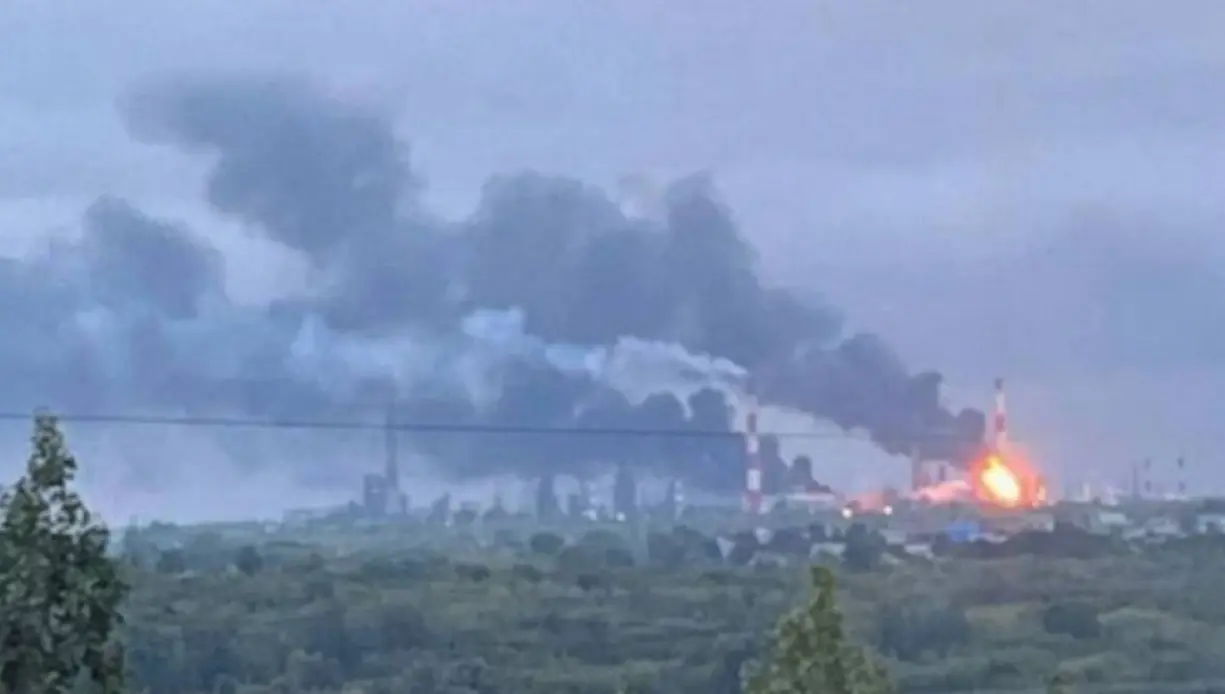


The General Staff reported “a target hit” at the facility and said explosions and fires were recorded at the site. Independent outlets carried multiple videos posted by residents that appeared to show plumes of smoke over the refinery complex. Reuters reported the strike and noted Ukraine also claimed a hit on Russia’s Caspian port of Olya the previous day.
Samara’s regional governor, Vyacheslav Fedorishchev, said the oblast came under a mass drone attack and that air defences shot down 13 drones, without directly acknowledging damage at the plant. Regional authorities activated a “Carpet” (Kovyór) emergency plan, with temporary airspace restrictions and limits on mobile internet reported locally. Ukrainian and Russian media noted residents had been urged not to post imagery of air-defence activity.
The Syzran refinery is part of Rosneft’s Samara group and, according to company information, has a crude distillation capacity of about 8.5 million tonnes per year. The plant produces motor fuels, aviation kerosene and bitumen, and processes both West Siberian and local crude streams. The city of Syzran lies roughly 800 kilometres from Ukraine’s border, placing the site well within the envelope of Kyiv’s growing long-range strike capability.
As of publication, the extent of damage at Syzran remained unverified. Reuters said Kyiv’s military reported fire and explosions at the refinery, while the governor referred only to an “industrial enterprise” and emphasised downing incoming drones. Previous incidents at the same plant this year disrupted operations: in February, Reuters reported Syzran suspended processing at a primary unit after a drone attack and fire.
The Syzran strike followed a series of attacks this month on Russian energy infrastructure. On 14 August, a drone attack set off a fire at Lukoil’s Volgograd refinery, according to Ukrainian and local reports. Earlier in August, Rosneft’s Ryazan refinery was operating at roughly half capacity after damage to key units; industry sources also reported stoppages at Novokuybyshevsk in the Samara cluster. The Moscow Times, citing industry sources and Reuters data, said disruptions as of 8 August had knocked nearly 10% of refining throughput offline.
Analysts assess that Ukraine has resumed a coordinated summer campaign against Russian fuel processing and logistics nodes using long-range uncrewed systems. El País reported that August has seen near-daily strikes on refineries and distribution assets, and highlighted recent use of domestically produced Liutyi drones in deep-strike missions that have reached as far as the Komi Republic. Kyiv’s objective, according to public statements, is to degrade Russia’s war-related fuel supply chain and impose economic costs, while Russia continues its own attacks on Ukrainian infrastructure.
Friday’s operation also carried diplomatic timing. Reuters noted the Syzran and Olya strikes were disclosed hours before a scheduled Trump–Putin summit in Anchorage, where the war in Ukraine is on the agenda. Kyiv has not been invited to the meeting. Markets reporting contemporaneously referenced softer oil prices ahead of the talks.
Conflicting claims about the number of drones involved and the level of damage are typical of long-range strikes deep inside Russia, where access for independent verification is limited. Russian outlets reported explosions, air-defence activity and fires in the Syzran area, while officials stressed interceptions; Ukrainian military channels emphasised successful impacts on fuel infrastructure. At the time of writing there were no official casualty figures linked to the refinery incident.
The Syzran plant’s role within Rosneft’s network is material for the southern Volga region’s civilian supply and for military fuel needs. Company data lists aviation fuel among its outputs. The refinery has been repeatedly targeted since 2024, with attacks in 2025 leading to at least temporary shutdowns of specific units. Should significant units at Syzran be offline for an extended period, Russia may again need to re-route crude flows and raise seaborne exports to manage inland stock balances, as analysts observed after earlier August disruptions.
The broader pattern—frequent strikes against refineries in Samara, Ryazan, Volgograd and other regions—suggests a sustained Ukrainian effort to reduce Russia’s refining flexibility ahead of autumn maintenance season. While Russia retains substantial spare capacity and alternative routes, repeated hits increase repair backlogs and complicate product logistics. The degree to which this affects military operations depends on redundancy in regional fuel distribution and prioritisation decisions by the defence ministry.
Modernised Ukrainian Drones Strike Deep Inside Russia: Kupol Air Defence Plant in Izhevsk Hit